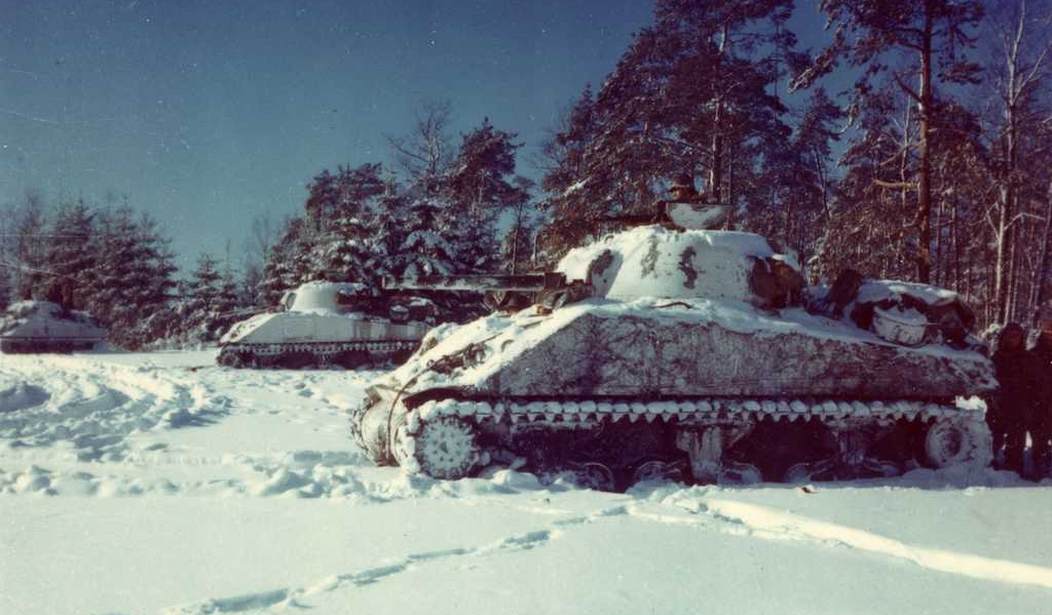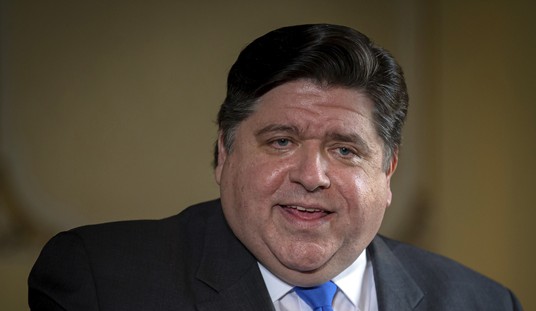At oh-dark-thirty on December 16, 1944, the sky and ground erupted to the sound of 1,600 German artillery pieces smashing Allied lines on a “quiet” sector of the Western Front. Seventeen German divisions plus the 150th Panzer Brigade, organized into three armies, led the initial assault on the outnumbered American men of the 2nd, 4th, 28th, 99th, 106th infantry divisions, and the 9th Armored Division. Many of the men were either untested or tired veterans, assigned to defend a sector where Allied headquarters believed a German counteroffensive to be unlikely.
Heavy snow kept Allied aircraft — usually the bane of German movements — grounded as nearly half a million Germans with thousands of guns and tanks raced behind Allied lines for their ultimate objective: The deepwater port of Antwerp which kept the Allied armies supplied.
Hitler’s goal for the deceptively named Unternehmen Wacht am Rhein (Operation Watch on the Rhine) was essentially a repeat of his 1940 invasion of France, which split the Anglo-French armies apart by launching a surprise offensive through the Ardennes Forest. It was believed by the Allies that the thick woods and underdeveloped road network would make an armored offensive impossible through the Ardennes, but Hitler did it anyway — twice. The first time, Hitler’s Fall Gelb (Case Yellow) successfully rolled up the Allies’ flanks, forcing the British to evacuate France at Dunkirk, and forcing the isolated and demoralized French to surrender after just six weeks of fighting. With the 1944 Ardennenoffensive, Hitler hoped to exploit the seam between the Anglo-American armies, and by seizing Antwerp, cut off their supply lines and force a favorable peace with the western Allies.

Hasso von Manteuffel led Fifth Panzer Army in the middle attack route. (Public domain.)
If Hitler’s dream of a second Ardennes offensive sounds fantastical, given the Allies’ numerical and qualitative advantages this late in the war, it probably was. Wacht am Rhein hinged on the weather staying bad enough the entire time to keep Allied aircraft out of the skies, and most crucially, the Germans had only enough fuel to make it maybe halfway to Antwerp. The “plan” (hope is not a plan) was that German forces would be able to capture enough Allied fuel stocks to make up the difference. If they couldn’t, those hundreds of tanks and thousands of guns and vehicles wouldn’t even be able to make a retreat, much less an advance against determined resistance.
When the initial assault came, Allied commanders were shocked by the flood of men and material pouring through the once-quiet Ardennes sector. After the first week or so, every day the German forces grew weaker and fewer, while the Americans grew stronger and more numerous. By Christmas Day, the German thrust had come to a halt. By mid-January, the Germans were in full retreat, often abandoning tanks and vehicles for lack of fuel. By the start of February, the Bulge had been all but erased, with the frontline back to where it had been on December 15. Allied casualties, overwhelmingly American, numbered around 91,000. German casualties were harder to count, but somewhere between 63,000-98,000. The Allies could make up the difference. The Germans could not.
Surely, Wacht am Rein was doomed at its conception, yet another of Hitler’s many operational follies.
Well, maybe not.
A successful outcome was never likely for the Germans, but it wasn’t impossible, either. If a few things had gone differently on the Allied side, Hitler could have conceivably pulled off a repeat of 1944:
• The initial American resistance was surprisingly stiff, considering that the lines were thinly manned, often by green or exhausted troops — without the usual air cover.
• American engineers never lost their cool, calmly blowing bridges and emptying fuel dumps. This slowed the German advance and denied Field Marshal Walter Model’s Army Group B the petrol it needed to speed on to Antwerp.
• U.S. Third Army Commander General George Patton anticipated a German counteroffensive and had prepared for the unexpected.
• Supreme Allied Commander Dwight Eisenhower correctly assessed the nature of the threat and responded accordingly.
When I say Patton was prepared, what that really means is that he’d prepared the men of Third Army for anything. This scene from Patton perfectly sums up the grim situation:
“They’ll do it because they’re good soldiers and because they realize as I do that we could still lose this war.”
Chilling stuff. But the Third Army did exactly what Patton promised they’d do. Mike Province, author of The Unknown Patton, said of the general in a 2012 interview, “No one else had the willpower and knowledge of the terrain. He turned the entire 3rd Army 90 degrees and headed north — about 200,000 men and 200 tanks. It took the sheer willpower of Patton.” Not only that, the Third Army pushed north 100 miles in two days, engaged the Germans on little or no rest, and then relieved the surrounded men of the 101st Airborne before the entire division could be killed or captured.
Back at the Allies’ Supreme Headquarters, Eisenhower’s calm and correct assessment of the situation requires some explanation, and it also contains the lessons needed for dealing with the 2020 coronavirus pandemic. The German salient — or “bulge” in popular wartime parlance — certainly looked threatening on the map, aimed like a dagger at Antwerp. But Ike kept his cool and was much less worried about the depth of the German penetration than he was about the width of the breach. In other words, Eisenhower was most concerned about the “shoulders,” the northern and southern points of the German breakthrough. If the shoulders could be kept narrow, then there would be an upper limit on the men, vehicles, and supplies that could be pushed through the rough terrain. If the shoulders gave way, then the German armies would roll up the Allied flanks and retake Antwerp. With the Allied armies starving in the field, Hitler’s dream of recapturing France and forcing a settlement on the US and Britain might have been made real.
Every effort was made to keep the shoulders close together. While Patton’s Third Army moved north toward Bastogne, U.S. First Army under General Courtney Hodges kept the northern shoulder strong around the Belgian town of Malmedy. The fierce fighting retreat from the Buldge played a significant role in preventing the Germans from achieving their early objectives, but keeping the Bulge’s shoulders narrow was the decisive element in the American victory. Winston Churchill said it was “undoubtedly the greatest American battle of the war.”
On the other side, the Germans remained trapped in a narrow salient, unable to widen the breach far enough to completely rupture the Allied front. While most Germans did manage to retreat back to their December 16 starting lines, they had to leave so much equipment behind that the entire Army Group B nearly ceased to exist as an armored fighting formation. Lacking room to grow, the German offensive withered on the vine, exactly as Eisenhower expected it to.
Flash forward to March of 2020, and there’s a new Battle of the Bulge: The fight to slow the rate of COVID-19 infection among the American people.

The “shoulders” in this case is the steepness of the virus’s growth curve. Keep that growth curve small in the early days, just as Eisenhower did with the shoulders of the Bulge, and the outbreak will largely wither on the vine.
The question is: How? Moving hundreds of thousands of men and armored vehicles around rough terrain under enemy fire, during the coldest January in memory might be child’s play compared to getting 320,000,000 restive Americans to do the right thing, but that’s exactly what all levels of government in America are trying to do — even if to a greater or lesser degree, depending on location.
Let’s look at South Korea, where “coronavirus cases have dropped sharply” in recent days, despite that country being the second major outbreak center after China. A report out today from Science magazine says that South Korea “has emerged as a sign of hope and a model to emulate.”
Details:
Behind its success so far has been the most expansive and well-organized testing program in the world, combined with extensive efforts to isolate infected people and trace and quarantine their contacts. South Korea has tested more than 270,000 people, which amounts to more than 5200 tests per million inhabitants—more than any other country except tiny Bahrain, according to the Worldometer website. The United States has so far carried out 74 tests per 1 million inhabitants, data from the U.S. Centers for Disease Control and Prevention show.
South Korea’s experience shows that “diagnostic capacity at scale is key to epidemic control,” says Raina MacIntyre, an emerging infectious disease scholar at the University of New South Wales, Sydney. “Contact tracing is also very influential in epidemic control, as is case isolation,” she says.
It might seem obvious, but identifying those who carry the Chinese flu, discovering who they’ve been in contact with, and then isolating them and their contacts from healthy people stops cold the spread of the disease. The problem for us is that while South Korea is a geographically compact country with a population of just 50 million people and limited ingress points, the United States is not. Not even close.
What we can do until testing kits become more widely available is what we’ve been doing: Avoiding large gatherings, maintaining social distance, and when necessary self-quarantining. Given the sheer size of our country and its huge population, this is probably the best we can do to limit that growth curve.
It might feel like an overreaction, closing down …dang near everything, it seems… just like it might have seemed like an overreaction for Patton to order three heavy divisions to disengage from one fight just to rush 100 miles in nasty weather to stop the Germans in a battle they’d probably lost before it began.
But extreme measures at the start of a crisis can prevent extreme consequences later on. That’s true in March of 2020, just like it was in December of 1944.
Given the incubation period for COVID-19, the next two weeks should, hopefully, prove whether or not our extreme measures have been extreme enough. I suspect, given our federal system and the wide range of governmental competence across the nation, that results will be mixed. The important thing, aside from lives saved, will be the lessons learned in what works and what doesn’t.
But maybe the most important lesson would be to emulate Ike, and keep our demeanor calm and our judgment sound right from the start of the crisis.










